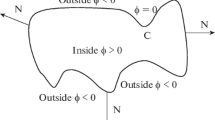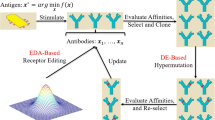Abstract
The segmentation is regarded as a vital step in preprocessing techniques for image analysis. Automatic segmentation of brain magnetic resonance images has been extensively investigated since with a precise segmentation can be identified and diagnosed several brain diseases. Thresholding is an important simple but efficient technique of image segmentation. Various strategies have been submitted to find optimal thresholds. Amongst those methods, the minimum cross-entropy (MCE) has been broadly implemented due to its simpleness. Although MCE is quite effective in bilevel thresholding, the computational cost increases exponentially the higher the number of thresholds (th) to find. This article introduces a new approach called MCE-SADE for multilevel thresholding using the Self-Adaptive Differential Evolution (SADE) algorithm. SADE is a robust metaheuristic algorithm (MA) that resolve general problems efficiently since, through evolution, the parameters and the proper learning strategy are continuously adjusted pursuant to prior knowledge. The optimum th values are found minimizing cross-entropy through SADE algorithm. The proposed method is tested in two groups of reference images; the primary group is formed of standard test images, while the following group consists of brain magnetic resonance images. In turn, MCE-SADE is compared with two metaheuristic algorithms, Grey Wolf Optimizer (GWO) and Competitive Imperialist Algorithm (ICA). From the experimental results, it is observed that MCE-SADE results improve in terms of consistency and quality in contrast to GWO and ICA based methods.
Access this chapter
Tax calculation will be finalised at checkout
Purchases are for personal use only
Similar content being viewed by others
References
T. Budrys, V. Veikutis, S. Lukosevicius, et al., Artifacts in magnetic resonance imaging: how it can really affect diagnostic image quality and confuse clinical diagnosis? J. Vibroeng. 20, 1202–1213 (2018). https://doi.org/10.21595/jve.2018.19756
S. Simu, S. Lal, A study about evolutionary and non-evolutionary segmentation techniques on hand radiographs for bone age assessment. Biomed. Signal Process. Control 33, 220–235 (2017). https://doi.org/10.1016/J.BSPC.2016.11.016
S. González-Villà, A. Oliver, S. Valverde et al., A review on brain structures segmentation in magnetic resonance imaging. Artif. Intell. Med. 73, 45–69 (2016). https://doi.org/10.1016/j.artmed.2016.09.001
T.X. Pham, P. Siarry, H. Oulhadj, Integrating fuzzy entropy clustering with an improved PSO for MRI brain image segmentation. Appl. Soft. Comput. J. 65, 230–242 (2018). https://doi.org/10.1016/j.asoc.2018.01.003
Z. Yang, Y. Shufan, G. Li, D. Weifeng, Segmentation of MRI brain images with an improved harmony searching algorithm. Biomed. Res. Int. (2016). https://doi.org/10.1155/2016/4516376
P. Moeskops, M.A. Viergever, A.M. Mendrik et al., Automatic segmentation of MR brain images with a convolutional neural network. IEEE Trans. Med. Imaging 35, 1252–1261 (2016). https://doi.org/10.1109/TMI.2016.2548501
R. Hiralal, H.P. Menon, A survey of brain MRI image segmentation methods and the issues involved (Springer, Cham, 2016), pp. 245–259
N. Otsu, A threshold selection method FROM gray-level histograms. IEEE Trans. Syst. Man. Cybern. 9, 62–66 (1979). https://doi.org/10.1109/TSMC.1979.4310076
J. Kittler, J. Illingworth, Minimum error thresholding. Pattern Recognit. 19, 41–47 (1986). https://doi.org/10.1016/0031-3203(86)90030-0
N.R. Pal, On minimum cross-entropy thresholding. Pattern Recognit. 29, 575–580 (1996). https://doi.org/10.1016/0031-3203(95)00111-5
A.G. Shanbhag, Utilization of information measure as a means of image thresholding. CVGIP Graph. Model Image Process. 56, 414–419 (1994). https://doi.org/10.1006/CGIP.1994.1037
M. Sezgin, B. Sankur, Survey over image thresholding techniques and quantitative performance evaluation. J. Electron. Imaging 13, 146 (2004). https://doi.org/10.1117/1.1631315
C.-I. Chang, Y. Du, J. Wang et al., Survey and comparative analysis of entropy and relative entropy thresholding techniques. IEEE Proc.—Vis. Image Signal Process. 153, 837 (2006). https://doi.org/10.1049/ip-vis:20050032
M.L. Menendez, Shannon’s entropy in exponential families: statistical applications. Appl. Math. Lett. 13, 37–42 (2000). https://doi.org/10.1016/S0893-9659(99)00142-1
J.N. Kapur, P.K. Sahoo, A.K.C. Wong, A new method for gray-level picture thresholding using the entropy of the histogram. Comput. Vis. Graph. Image Process. 29, 273–285 (1985). https://doi.org/10.1016/0734-189X(85)90125-2
C.H. Li, C.K. Lee, Minimum cross entropy thresholding. Pattern Recognit. 26, 617–625 (1993). https://doi.org/10.1016/0031-3203(93)90115-D
C. Tsallis, Computational applications of nonextensive statistical mechanics. J. Comput. Appl. Math. 227, 51–58 (2009). https://doi.org/10.1016/J.CAM.2008.07.030
E. Beadle, J. Schroeder, B. Moran, S. Suvorova, An overview of Renyi Entropy and some potential applications, in 2008 42nd Asilomar Conference on Signals, Systems and Computers (IEEE, 2008), pp. 1698–1704
V. Osuna-Enciso, E. Cuevas, H. Sossa, A comparison of nature inspired algorithms for multi-threshold image segmentation. Expert Syst. Appl. 40, 1213–1219 (2013). https://doi.org/10.1016/J.ESWA.2012.08.017
J. Zhang, H. Li, Z. Tang, et al., (2014) An improved quantum-inspired genetic algorithm for image multilevel thresholding segmentation. Math. Probl. Eng. (2014). https://doi.org/10.1155/2014/295402
Y. Wang, Improved OTSU and adaptive genetic algorithm for infrared image segmentation, in 2018 Chinese Control and Decision Conference (CCDC) (IEEE, 2018), pp. 5644–5648
Y. Li, S. Wang, J. Xiao, Image segmentation based on dynamic particle swarm optimization for crystal growth. Sensors 18, 3878 (2018). https://doi.org/10.3390/s18113878
M.F. Di, S. Sessa, PSO image thresholding on images compressed via fuzzy transforms. Inf. Sci. (Ny) 506, 308–324 (2020). https://doi.org/10.1016/J.INS.2019.07.088
H.V.H. Ayala, F.M. dos Santos, V.C. Mariani, L. dos Santos Coelho, Image thresholding segmentation based on a novel beta differential evolution approach. Expert Syst. Appl. 42, 2136–2142 (2015). https://doi.org/10.1016/J.ESWA.2014.09.043
E. Cuevas, D.P.-C.M. Zaldivar, A novel multi-threshold segmentation approach based on differential evolution optimization. Expert Syst. Appl. 37, 5265–5271 (2010). https://doi.org/10.1016/j.eswa.2010.01.013
U. Mlakar, B. Potočnik, J. Brest, A hybrid differential evolution for optimal multilevel image thresholding. Expert Syst. Appl. 65, 221–232 (2016). https://doi.org/10.1016/j.eswa.2016.08.046
E. Cuevas, F. Sención, D. Zaldivar et al., A multi-threshold segmentation approach based on artificial bee colony optimization. Appl. Intell. 37, 321–336 (2012). https://doi.org/10.1007/s10489-011-0330-z
S. Zhan, W. Jiang, S. Satoh, Multilevel thresholding color image segmentation using a modified artificial bee colony algorithm. IEICE Trans. Inf. Syst. 101, 2064–2071 (2018). https://doi.org/10.1587/transinf.2017EDP7183
D. Oliva, E. Cuevas, G. Pajares, et al., Multilevel thresholding segmentation based on harmony search optimization. J. Appl. Math. (2013). https://doi.org/10.1155/2013/575414
V. Tuba, M. Beko, M. Tuba, Color Image Segmentation by Multilevel Thresholding Based on Harmony Search Algorithm (Springer, Cham, 2017), pp. 571–579
T. Kaur, B.S. Saini, S. Gupta, Optimized Multi Threshold Brain Tumor Image Segmentation Using Two Dimensional Minimum Cross Entropy Based on Co-occurrence Matrix (Springer, Cham, 2016), pp. 461–486
D. Oliva, S. Hinojosa, E. Cuevas, G. Pajares, O.G.J. Avalos, Cross entropy based thresholding for magnetic resonance brain images using Crow Search Algorithm. Expert Syst. Appl. 79, 164–180 (2017). https://doi.org/10.1016/j.eswa.2017.02.042
P.D. Sathya, R. Kayalvizhi, Amended bacterial foraging algorithm for multilevel thresholding of magnetic resonance brain images. Meas. J. Int. Meas. Confed. 44, 1828–1848 (2011). https://doi.org/10.1016/j.measurement.2011.09.005
M. Ali, P. Siarry, M. Pant, Multi-level image thresholding based on hybrid differential evolution algorithm. Application on Medical Images (Springer, Berlin, Heidelberg, 2017), pp. 23–36
G. Chen, Z. Yang Z (2009) Preserving and exploiting genetic diversity in evolutionary programming algorithms. IEEE Trans. Evol. Comput. 13. https://doi.org/10.1109/TEVC.2008.2011742
D.H. Wolpert, W.G. Macready, No free lunch theorems for optimization. IEEE Trans. Evol. Comput. 1, 67–82 (1997). https://doi.org/10.1109/4235.585893
D. Shilane, J. Martikainen, S. Dudoit, S.J. Ovaska, A general framework for statistical performance comparison of evolutionary computation algorithms. Inf. Sci. (Ny) 178, 2870–2879 (2008). https://doi.org/10.1016/J.INS.2008.03.007
S. Mirjalili, S.M. Mirjalili, A. Lewis, Grey wolf optimizer. Adv. Eng. Softw. 69, 46–61 (2014). https://doi.org/10.1016/j.advengsoft.2013.12.007
A.E. Gargari, C. Lucas, Imperialist competitive algorithm : an algorithm for optimization inspires by imperialistic competition. IEEE Congr. Evol. Comput., 4661–4667 (2007)
S. Kullback, Information Theory and Statistics (Dover Publications, 1968)
R. Storn, K. Price, Differential evolution—A simple and efficient heuristic for global optimization over continuous spaces. J. Glob. Optim. 11, 341–359 (1997)
A.T. Buba, L.S. Lee, A differential evolution for simultaneous transit network design and frequency setting problem. Expert Syst. Appl. 106, 277–289 (2018). https://doi.org/10.1016/J.ESWA.2018.04.011
B. Bošković, J. Brest, Protein folding optimization using differential evolution extended with local search and component reinitialization. Inf. Sci. (Ny) 454–455, 178–199 (2018). https://doi.org/10.1016/J.INS.2018.04.072
D.M. Diab, K. El Hindi, Using differential evolution for improving distance measures of nominal values. Appl. Soft. Comput. 64, 14–34 (2018). https://doi.org/10.1016/J.ASOC.2017.12.007
M.G. Villarreal-Cervantes, E. Mezura-Montes, J.Y. Guzmán-Gaspar, Differential evolution based adaptation for the direct current motor velocity control parameters. Math. Comput. Simul. 150, 122–141 (2018). https://doi.org/10.1016/J.MATCOM.2018.03.007
S. Maggi, Estimating water retention characteristic parameters using differential evolution. Comput. Geotech. 86, 163–172 (2017). https://doi.org/10.1016/J.COMPGEO.2016.12.025
A.K. Qin, V.L. Huang, P.N. Suganthan, Differential evolution Algorithm with strategy adaptation for global numerical optimization. IEEE Commun. Mag. 13, 398–417 (2009). https://doi.org/10.1109/TEVC.2008.927706
J.E. Baker, Reducing bias and inefficiency in the selection algorithm, in Proceedings of the Second International Conference on Genetic Algorithms, 28–31 July 1987, Massachusetts Institute of Technology, MA (1987)
S. Sarkar, S. Paul, R. Burman et al., A Fuzzy Entropy Based Multi-Level Image Thresholding Using Differential Evolution (Springer, Cham, 2015), pp. 386–395
A.K.M. Khairuzzaman, S. Chaudhury, Multilevel thresholding using grey wolf optimizer for image segmentation. Expert Syst. Appl. 86, 64–76 (2017). https://doi.org/10.1016/j.eswa.2017.04.029
M. Nejad, M. Fartash, Applying chaotic imperialist competitive algorithm for multi-level image thresholding based on Kapur’s entropy. Adv. Sci. Technol. Res. J. 10, 125–131 (2016). https://doi.org/10.12913/22998624/61940
B. Sankur, B. Sankur, K. Sayood, Statistical evaluation of image quality measures. J Electron. Imaging 11, 206 (2002). https://doi.org/10.1117/1.1455011
Z. Wang, A.C. Bovik, H.R. Sheikh, E.P. Simoncelli, Image quality assessment: from error visibility to structural similarity. IEEE Trans. Image Process. 13, 600–612 (2004). https://doi.org/10.1109/TIP.2003.819861
L. Zhang, L. Zhang, X. Mou, D. Zhang, FSIM: a feature similarity index for image quality assessment. IEEE Trans. Image Process. 20, 2378–2386 (2011). https://doi.org/10.1109/TIP.2011.2109730
P. Ghamisi, M.S. Couceiro, J.A. Benediktsson, N.M.F. Ferreira, An efficient method for segmentation of images based on fractional calculus and natural selection. Expert Syst. Appl. 39, 12407–12417 (2012). https://doi.org/10.1016/J.ESWA.2012.04.078
F. Wilcoxon, Individual comparisons by ranking methods. Biometrics Bull. 1, 80–83 (1945)
S. García, D. Molina, M. Lozano, F. Herrera, A study on the use of non-parametric tests for analyzing the evolutionary algorithms’ behaviour: a case study on the CEC’2005 Special Session on Real Parameter Optimization. J. Heuristics 15, 617–644 (2009). https://doi.org/10.1007/s10732-008-9080-4
Author information
Authors and Affiliations
Corresponding author
Editor information
Editors and Affiliations
Rights and permissions
Copyright information
© 2020 Springer Nature Switzerland AG
About this chapter
Cite this chapter
Aranguren, I., Valdivia, A., Pérez, M.A. (2020). Segmentation of Magnetic Resonance Brain Images Through the Self-Adaptive Differential Evolution Algorithm and the Minimum Cross-Entropy Criterion. In: Oliva, D., Hinojosa, S. (eds) Applications of Hybrid Metaheuristic Algorithms for Image Processing. Studies in Computational Intelligence, vol 890. Springer, Cham. https://doi.org/10.1007/978-3-030-40977-7_14
Download citation
DOI: https://doi.org/10.1007/978-3-030-40977-7_14
Published:
Publisher Name: Springer, Cham
Print ISBN: 978-3-030-40976-0
Online ISBN: 978-3-030-40977-7
eBook Packages: Intelligent Technologies and RoboticsIntelligent Technologies and Robotics (R0)




